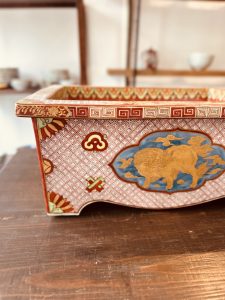古代の魔除けからラーメン鉢まで繋がっております(愛知県名古屋市千種区姫池通 骨董買取 古美術風光舎)
2024.09.11
皆さまこんにちは。スタッフHでございます。
スタッフYのブログにもありましたが、私も少しだけでも秋を感じようと虫の音を聞くために夕方窓を開けます。あまりの蒸し暑さにすぐに閉めざるを得ないのですが。
最近は天候が不安定で突然の大雨や雷による混乱が増えていますね。私はとにかく雷が苦手で、といいますか雷の音にかなりダメージを受けます。そんなに大きな音でなくても思わず叫んでしまうので、恥ずかしい思いをしたこともあります。なんとかならないものかと自分でも思うのですが中々難しいところです。
さて風光舎には雷光を表しているとも言われる雷紋(らいもん)が施された九谷焼の水盤がございます。雷紋は渦巻形が方形になった文様で、複数個連なって構成されることが多いようです。九谷焼では古九谷の時代からこの雷紋がよく描かれています。

凡人ですのでこの雷紋を見てまず思い浮かぶのはやはり「ラーメン鉢」。美味しい麺をすする間、常に視界に入ってくる模様ですから記憶に定着しない訳がありません。雷紋がラーメンの鉢に行きつくまでには長い年月があり、このシンプルな紋様は古の人々から大切に受け継がれてきたようです。
雷紋の歴史は古く、日本では弥生時代には既に存在し、室町時代には家紋として雷紋が使用され48種類のデザインがあるそうです。雷紋は中国から日本へ伝わったとされており、中国では殷の時代の青銅器に多く見られ、伝統的な幾何学文様として知られています。
雨をもたらす雷光は五穀豊穣を象徴し、迷路のような形から魔除けの意味もありました。また文様が連続して用いられることが多いため、不断長久を願う吉祥文様とされてきました。日本の家紋に用いられたのはこのためかもしれませんね。
日本の大和言葉の「かみなり」は神が鳴らすものと信じられ「神鳴り」からきているとのこと。雷光は大和言葉では「いなずま・いなづま」とも呼ばれ、旧暦の夏から秋の始めにかけて発生する雷が稲穂に感光することで開花し実を結ぶという信仰が生まれ「稲の妻(配偶者)」から「稲妻」と呼ばれるようになったそうです。
まだ科学という概念もない時代、空に轟く雷鳴がまさに神様からのお告げのように感じたことは不思議ではありません。
ちなみに日本語の「雷」は音も光も表せますが、英語では雷の音は「thunder(サンダー)」、雷の光は「lightning(ライトニング)」と厳密に区別されているようで、英語の授業で厳しく注意された記憶があります。
そんなに強く言わなくても、どっちでもいいのではと言葉の壁を感じたのをふと思い出しました。
話を戻しますが、雷紋は中国が起源なのだなと思っていたら、別の遠い国でも昔から存在していたとのこと。
新石器時代のギリシャでもこの文様が魔除けや幸福のシンボルとなっていました。ギリシャではメアンドロス川という川の名前に由来し「メアンダー模様」「メアンドロス模様」とも呼ばれているようです。この川の蛇行した様子がモチーフになっているとも言われています。その後歴史的な建造物や陶器にも使用されるようになり、家具の装飾にも使われていきます。
では中国の雷をモチーフにした雷紋とギリシャの川の流れをモチーフにした雷紋「メアンダー模様」は別々に自然発生したのでしょうか。それともどこかで繋がったことがあったのでしょうか。調べてみてもあまりはっきりとしが答えは見つかりませんでした。そもそも紀元前のお話ですから想像を巡らせる楽しみにしておきましょう。
虫の音のように、同じものを見たり聞いたりしても違う捉え方をする中で、違うものを見て同じイメージを浮かべたのだとしたら人間て面白いですね。
最後にラーメン鉢の雷紋に戻りますが(忘れてはおりません)、1910年にに日本初のラーメン店がオープンした頃、ラーメン専用の鉢として浅草の九谷焼を扱う陶器卸専門店に「中華料理らしい器」を依頼しました。こちらのお店「小松屋」は石川県小松町(現小松市)から上京した本清太郎氏が九谷焼を広めようと始めたお店だそうです。依頼を受け、九谷焼で昔から馴染のある雷紋を鉢に施したのが始まりとされています。
その後ラーメン店は次々と増え、それに伴い雷紋のラーメン鉢が日本全国に浸透していったとか。
なんだか無性にラーメンが食べたくなってきました。
それでは、また次の機会に
Hello everyone. This is Staff H.
As mentioned in Staff Y’s blog, I open the window in the evening to listen to the sound of insects in order to feel the autumn at least a little. But it is so hot and humid that I have to close the window immediately.
The weather has been unstable lately, with sudden heavy rain and thunderstorms causing more and more chaos. I am not good at thunder anyway, or rather, the sound of thunder is quite damaging to me. Even if the sound is not that loud, I scream unintentionally, and I have been embarrassed by it. I wish I could do something about it, but it’s not easy.
Now, at Fuhkosha, we have a Kutaniyaki water basin decorated with a raimon, which is said to represent a thunderbolt. The raimon is a square pattern of spirals, and is often composed of several pieces in a row. In Kutani ware, this thunder pattern has been often depicted since the Ko-Kutani period.
As an ordinary person, the first thing that comes to mind when I see this lightning pattern is a “ramen bowl. It is impossible for this pattern not to stick in one’s memory because it is always in one’s field of vision while slurping down the delicious noodles. It took many years for the lightning pattern to find its way to the ramen bowl, and this simple pattern seems to have been carefully passed down from generation to generation.
The history of the thunder pattern is long, already existing in Japan in the Yayoi period (710-794), and in the Muromachi period (1333-1573), the thunder pattern was used as a family crest, and there are 48 different designs. It is said that the thunderbolt pattern was introduced to Japan from China, and in China, it is often seen on bronze vessels from the Shang Dynasty, and is known as a traditional geometric pattern.
The thunderbolt that brings rain symbolizes a bountiful harvest, and its maze-like shape was also meant to ward off evil. The pattern is often used in succession, so it has been regarded as an auspicious design to wish for perpetuity and longevity. This may be the reason why it was used as a family crest in Japan.
Kaminari” in the Japanese Yamato language comes from ‘kaminari,’ which is believed to be sounded by a god and is derived from ”kaminari. Thunderbolt is also called “Inazuma/Inazuma” in the Yamato language, and is said to have come to be called “Inazuma” from “Inazuma (wife) of rice,” from the belief that the lightning that occurs from summer to early autumn in the lunar calendar causes the rice ears to blossom and bear fruit when they are sensitized.
It is not surprising that in an age when the concept of science had not yet been invented, the thunder roaring in the sky felt like a sign from the gods.
Incidentally, the Japanese word “thunder” can be used to describe both sound and light, but in English, the sound of thunder is strictly distinguished as “thunder” and the light of lightning as “lightning,” and I remember being strictly warned in English class.
I suddenly remembered that I felt a language barrier, thinking that I did not have to say it so strongly, and that it was fine either way.
Back to the story, I thought that the lightning crest must have originated in China, but I was told that it had existed in another distant country for a long time.
Even in Neolithic Greece, this pattern was a symbol of protection against evil and happiness. In Greece, it is also called “meander pattern” or “meandros pattern,” derived from the name of the river Meandros. It is said that the meanderings of the river were the motif of the pattern. Later, it came to be used on historical buildings and pottery, and was also used to decorate furniture.
So, did the Chinese thunder pattern, which is based on lightning, and the Greek thunder pattern, “meander pattern,” which is based on a flowing river, arise spontaneously separately? Or were they connected at some point? I could not find a very clear answer in my research. Since this is a story from B.C. to begin with, let’s enjoy letting our imagination run wild.
It would be interesting to know if people could see and hear the same thing but perceive it in different ways, like the sound of an insect, and if they could see different things and conjure up the same image.
Finally, returning to the lightning pattern on the ramen bowl (I have not forgotten), when the first ramen restaurant in Japan opened in 1910, I asked a pottery wholesaler specializing in Kutani ware in Asakusa to create “a bowl that is typical of Chinese cuisine” as a bowl exclusively for ramen. This store, Komatsuya, was started by Seitaro Moto, who came to Tokyo from Komatsu Town (now Komatsu City) in Ishikawa Prefecture, to promote Kutani ware. Upon receiving a request, he applied the thunderbolt pattern, which has been familiar in Kutani ware for a long time, to a bowl.
The number of ramen stores increased one after another, and ramen bowls with the lightning pattern spread throughout Japan along with it.
I have an uncontrollable craving for ramen.
See you next time!
*******************
ご実家の整理やお片付けなどをされている方のご相談などが多くございます。
お片付けなどくれぐれもご無理のないようになさってくださいませ。
風光舎では古美術品や骨董品の他にも絵画や宝石、趣味のお品など様々なジャンルのものを買受しております。
お片付けをされていて、こういうものでもいいのかしらと迷われているものでも、どうぞお気軽にご相談下さいませ。
また風光舎は、出張買取も強化しております。ご近所はもちろん、愛知県内、岐阜県、三重県その他の県へも出張いたします。
なお、毎月21日の持込鑑定会では無料鑑定・買取・ご相談など、ご予約なしで承っております。
ご近所の皆さま、ご遠方のみなさまも、お気軽にお越しくださいませ。
まずは、お電話お待ちしております。
愛知県名古屋市千種区姫池通
骨董 買取【古美術 風光舎 名古屋店】
TEL052(734)8444
10:00-18:00 OPEN
#出張買取#骨董#古美術#骨董品#絵画#版画#茶道具#刀剣#彫刻

